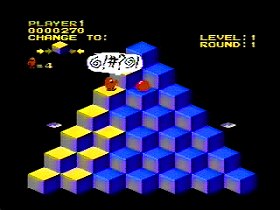 The Game: Q*Bert, a nosey little guy with a propensity for hopping, spends his time hopping around a three-dimensional pyramid of cubes, avoiding Coily the Snake and other assorted purple and red creatures, including a few who operate on a slightly different plane (i.e., they move down the pyramid as if it were rotated one-third). Any green objects and creatures Q*Bert can catch will not hurt him – in fact, the little bouncing green balls will stop time briefly for everyone but Q*Bert. If he gets into a tight spot, Q*Bert can jump off the pyramid onto a flying disc which will despoit him back at the top of the pyramid – and lure Coily to a nasty fate by jumping into nothing. Changing the colors of the top of every cube in the pyramid to the target color indicated at the top left of the screen will clear the pyramid and start the craziness all over again. If Q*Bert is hit by an enemy or falls off the pyramid, he hits bottom with a resounding, arcade- cabinet-shaking splat and a burst of incomprehensible obscenity! (Konami/Ultra, 1989)
The Game: Q*Bert, a nosey little guy with a propensity for hopping, spends his time hopping around a three-dimensional pyramid of cubes, avoiding Coily the Snake and other assorted purple and red creatures, including a few who operate on a slightly different plane (i.e., they move down the pyramid as if it were rotated one-third). Any green objects and creatures Q*Bert can catch will not hurt him – in fact, the little bouncing green balls will stop time briefly for everyone but Q*Bert. If he gets into a tight spot, Q*Bert can jump off the pyramid onto a flying disc which will despoit him back at the top of the pyramid – and lure Coily to a nasty fate by jumping into nothing. Changing the colors of the top of every cube in the pyramid to the target color indicated at the top left of the screen will clear the pyramid and start the craziness all over again. If Q*Bert is hit by an enemy or falls off the pyramid, he hits bottom with a resounding, arcade- cabinet-shaking splat and a burst of incomprehensible obscenity! (Konami/Ultra, 1989)
Memories: Ah, the eternal conundrum of Q*Bert – to turn the controller, or try to do diagonals with an NES joypad? The original arcade incarnation of the mighty orange one solved the problem pretty simply by turning a standard four-directional joystick at a 45-degree angle within the coin-op’s casing. To truly replicate that effect, you’re given the option of rotating the NES controller 45 degrees or to try to do diagonals while holding it straight (in effect, hitting the left and down portions of the plus-shaped pad simultaneously to move in that direction). There’s a whole pre-game startup screen devoted to controller orientation here. And as awkward as it is, the 45-degree angle option is much more responsive on the NES. Now, a joystick such as the Advantage may help here, but again, the hardware itself dictates that the controller won’t be as responsive diagonally.
 The Game: As the offspring of a round yellow creature consisting of a mouth and nothing else, you maneuver around a bigger maze than your parents ever had to deal with, gobbling small dots and evading four colorful monsters who can eat you on contact. Six large flashing dots in the maze enable you to turn the tables and eat the monsters for a brief period. Periodically, assorted toys will begin hopping through the maze, turning every uneaten dot they touch into a larger dot which yields more points, but also forces little Pac to slow down to digest them. (Atari, 1987)
The Game: As the offspring of a round yellow creature consisting of a mouth and nothing else, you maneuver around a bigger maze than your parents ever had to deal with, gobbling small dots and evading four colorful monsters who can eat you on contact. Six large flashing dots in the maze enable you to turn the tables and eat the monsters for a brief period. Periodically, assorted toys will begin hopping through the maze, turning every uneaten dot they touch into a larger dot which yields more points, but also forces little Pac to slow down to digest them. (Atari, 1987)
 The Game: As the bride of that most famous of single-celled omniphage life forms, your job is pretty simple – eat all the dots, gulp the large blinking dots in each corner of the screen and eat the monsters while they’re blue, and avoid the monsters the rest of the time. Occasionally various fruits and other foods will bounce through the maze, and you can gobble those for extra points. (Atari, 1984; released circa 1987)
The Game: As the bride of that most famous of single-celled omniphage life forms, your job is pretty simple – eat all the dots, gulp the large blinking dots in each corner of the screen and eat the monsters while they’re blue, and avoid the monsters the rest of the time. Occasionally various fruits and other foods will bounce through the maze, and you can gobble those for extra points. (Atari, 1984; released circa 1987)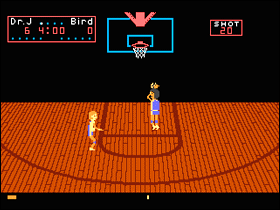 The Game: Dr. J and Larry Bird take to the hardwood for one-on-one half-court basketball action. Each player has his own signature moves, from lay-ups to three-point shots to steals. One or two players can play to a predetermined score or to a time limit. (Atari [under license from Electronic Arts], 1987)
The Game: Dr. J and Larry Bird take to the hardwood for one-on-one half-court basketball action. Each player has his own signature moves, from lay-ups to three-point shots to steals. One or two players can play to a predetermined score or to a time limit. (Atari [under license from Electronic Arts], 1987)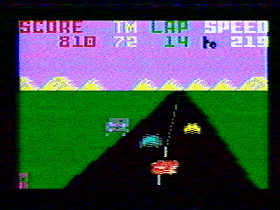 The Game: Prepare to qualify! Fly to the finish line in a fierce field of Formula One competitors in a qualifying lap. Leaving the track is trouble – and hitting one of the billboards dotted around the edges of the Mt. Fuji track is a sure way to miss out on the subsequent race. (INTV Corp., 1987)
The Game: Prepare to qualify! Fly to the finish line in a fierce field of Formula One competitors in a qualifying lap. Leaving the track is trouble – and hitting one of the billboards dotted around the edges of the Mt. Fuji track is a sure way to miss out on the subsequent race. (INTV Corp., 1987) The Game: It’s your big chance to qualify for the big race at one of four tracks: the oval test track, Seaside, Suzuka, and the Mt. Fuji track from the original Pole Position. First, you try to get through the qualifying heat, racking up laps around the track as fast you can and accumulating as few wrecks as possible. If you pass muster, then you get to try it again with other cars on the track! (Atari, 1984; released circa 1987)
The Game: It’s your big chance to qualify for the big race at one of four tracks: the oval test track, Seaside, Suzuka, and the Mt. Fuji track from the original Pole Position. First, you try to get through the qualifying heat, racking up laps around the track as fast you can and accumulating as few wrecks as possible. If you pass muster, then you get to try it again with other cars on the track! (Atari, 1984; released circa 1987)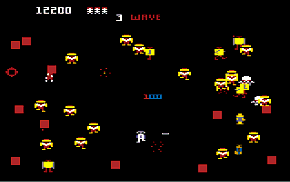 The Game: In the year 2084, all hell has broken loose on Earth. Robotic servants, created to perform dangerous tasks and defend their human creators, have decided they can do without their masters. The robots have evolved into new and terrifying varieties – the ever-multiplying Ground Roving UNit Terminators (GRUNTs), indestructible Hulks, self-replicating Quarks and Tanks, and most horrfying of all, the Brain robots, which capture humans and reprogram them into super-fast killing machines. And the only thing protecting the last remaining survivors of homo sapiens is your strength, endurance and cunning. (Atari, 1984 [released in 1987])
The Game: In the year 2084, all hell has broken loose on Earth. Robotic servants, created to perform dangerous tasks and defend their human creators, have decided they can do without their masters. The robots have evolved into new and terrifying varieties – the ever-multiplying Ground Roving UNit Terminators (GRUNTs), indestructible Hulks, self-replicating Quarks and Tanks, and most horrfying of all, the Brain robots, which capture humans and reprogram them into super-fast killing machines. And the only thing protecting the last remaining survivors of homo sapiens is your strength, endurance and cunning. (Atari, 1984 [released in 1987])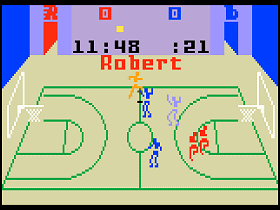 The Game: One or two players can set a budget and begin recruiting a top-notch basketball team (or, alternately, recruiting from who’s left after someone else has recruited a top-notch basketball team), and then it’s time to hit the court. Each player controls a team of three with offensive and defensive moves; the player can control any member of his team. (INTV Corp., 1987)
The Game: One or two players can set a budget and begin recruiting a top-notch basketball team (or, alternately, recruiting from who’s left after someone else has recruited a top-notch basketball team), and then it’s time to hit the court. Each player controls a team of three with offensive and defensive moves; the player can control any member of his team. (INTV Corp., 1987)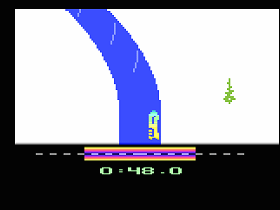 The Game: The Olympic torch is the warmest thing to be found in this multi-event recreation of the Winter Olympics. Downhill skiing, luge, slalom skiing and other events are represented here, and players can even pick which country they’re representing as they go for the gold. (Epyx, 1987)
The Game: The Olympic torch is the warmest thing to be found in this multi-event recreation of the Winter Olympics. Downhill skiing, luge, slalom skiing and other events are represented here, and players can even pick which country they’re representing as they go for the gold. (Epyx, 1987)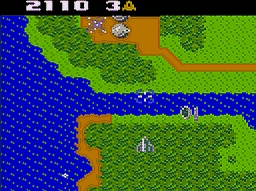 The Game: As the commander of a sleek Solvalou fighter, you’re deep into enemy territory, shooting their disc-shaped fighters out of the sky, bombing ground installations and artillery nests, bombing tanks, and trying to destroy the mothership. As you progress further behind enemy lines, heavier aircraft and more versatile and deadly ground-based defenses become the norm. Also look out for tumbling airborne mirrors – they’re impervious to your fire, but you’re toast if you fly right into them. (Atari, 1984; released circa 1987)
The Game: As the commander of a sleek Solvalou fighter, you’re deep into enemy territory, shooting their disc-shaped fighters out of the sky, bombing ground installations and artillery nests, bombing tanks, and trying to destroy the mothership. As you progress further behind enemy lines, heavier aircraft and more versatile and deadly ground-based defenses become the norm. Also look out for tumbling airborne mirrors – they’re impervious to your fire, but you’re toast if you fly right into them. (Atari, 1984; released circa 1987)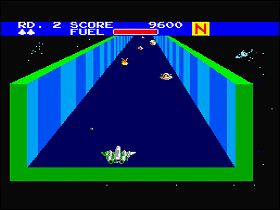 The Game: As the lone pilot daring enough to breach the defenses of Zaxxon’s space stronghold yet again, you take on a fleet of perimeter fighters, some of whom helpfully leave power-ups behind when destroyed. Then it’s into the space base once more, bristling with gun emplacements, fuel tanks that gas up your fighter when they’re shot (we haven’t quite worked that one out either), and walls that you can run face-first if you’re at just the wrong altitude. Just beyond the walls of the base lies the new and improved Zaxxon itself; if you survive that encounter, you begin again. (Sega, 1987)
The Game: As the lone pilot daring enough to breach the defenses of Zaxxon’s space stronghold yet again, you take on a fleet of perimeter fighters, some of whom helpfully leave power-ups behind when destroyed. Then it’s into the space base once more, bristling with gun emplacements, fuel tanks that gas up your fighter when they’re shot (we haven’t quite worked that one out either), and walls that you can run face-first if you’re at just the wrong altitude. Just beyond the walls of the base lies the new and improved Zaxxon itself; if you survive that encounter, you begin again. (Sega, 1987)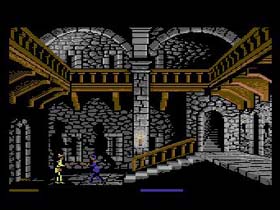 The Game: The King of England has been assassinated and the crown has gone missing! To regain the crown and restore order you’ll need to conquer the entire country, one castle at a time. Equal parts strategy and action make for lots of fun and replayability. The ultimate cinematic experience for the Commodore 64. (Cinemaware, 1987)
The Game: The King of England has been assassinated and the crown has gone missing! To regain the crown and restore order you’ll need to conquer the entire country, one castle at a time. Equal parts strategy and action make for lots of fun and replayability. The ultimate cinematic experience for the Commodore 64. (Cinemaware, 1987)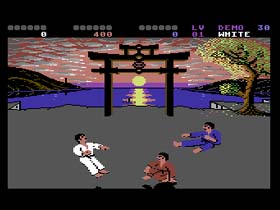 The Game: Face not one but two simultaneous opponents in what many consider the apex of Commodore 64 fighting games. IK+ supports one or two players, eighteen different moves, and more fighting action than all of Jean-Claude Van Damme’s movies combined. (System 3, 1987)
The Game: Face not one but two simultaneous opponents in what many consider the apex of Commodore 64 fighting games. IK+ supports one or two players, eighteen different moves, and more fighting action than all of Jean-Claude Van Damme’s movies combined. (System 3, 1987)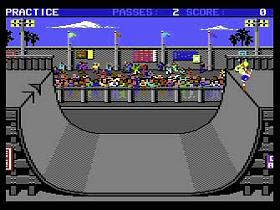 The Game: Don’t be a poseur! Skate hard or die trying in the ultimate skateboarding game for the Commodore 64. Practice or compete in five separate events that will lead you over ramps, down streets and even into abandoned pools. (Electronic Arts, 1987)
The Game: Don’t be a poseur! Skate hard or die trying in the ultimate skateboarding game for the Commodore 64. Practice or compete in five separate events that will lead you over ramps, down streets and even into abandoned pools. (Electronic Arts, 1987) The Game: Wonderboy’s girlfriend Tanya has been abducted and it’s up to you to get her back. You’ll have to be pretty crafty to avoid the dangers of Wonderland in this classic Sega platformer. (Activision, 1987)
The Game: Wonderboy’s girlfriend Tanya has been abducted and it’s up to you to get her back. You’ll have to be pretty crafty to avoid the dangers of Wonderland in this classic Sega platformer. (Activision, 1987) The Game: You control a daredevil stunt climber on his trip up the side of a skyscraper in a major metropolitan area, using no ropes, no nets, and nothing but his hands and his feet. Obstacles such as falling jam boxes can cause you to plunge to your death several stories below. When you reach the top – if you reach the top, that is – a helicopter lifts you away to your next challenge. (Nihon Bussan Co., Ltd. [Nichibutsu], 1988)
The Game: You control a daredevil stunt climber on his trip up the side of a skyscraper in a major metropolitan area, using no ropes, no nets, and nothing but his hands and his feet. Obstacles such as falling jam boxes can cause you to plunge to your death several stories below. When you reach the top – if you reach the top, that is – a helicopter lifts you away to your next challenge. (Nihon Bussan Co., Ltd. [Nichibutsu], 1988) The Game: An adorable kitten (and his twin, in the case of two-player games) runs and jumps around a maze of obstacles, trying to stay out of the clutches of such enemies as an insect in a lab coat, a large and angry-looking tomato, and a crocodile that walks upright. (Further levels add new and even stranger enemies to avoid.) The kitten(s) can push the blocks making up the maze, hopefully smashing an enemy against another block or one of the playfield’s outer walls in the process, temporarily removing that enemy from play. A defeated enemy drops numerous items, including coins, diamonds, and one of several keys needed to open a door allowing access to the next level of the game. (Konami, 1988)
The Game: An adorable kitten (and his twin, in the case of two-player games) runs and jumps around a maze of obstacles, trying to stay out of the clutches of such enemies as an insect in a lab coat, a large and angry-looking tomato, and a crocodile that walks upright. (Further levels add new and even stranger enemies to avoid.) The kitten(s) can push the blocks making up the maze, hopefully smashing an enemy against another block or one of the playfield’s outer walls in the process, temporarily removing that enemy from play. A defeated enemy drops numerous items, including coins, diamonds, and one of several keys needed to open a door allowing access to the next level of the game. (Konami, 1988)

 The Game: Batter up! We’re live from the baseball diamond with TV sports-style camera angles that switch to show you where the action is. (Absolute, 1988)
The Game: Batter up! We’re live from the baseball diamond with TV sports-style camera angles that switch to show you where the action is. (Absolute, 1988)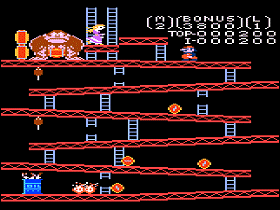 The Game: An oversized gorilla kidnaps Mario’s girlfriend and hauls her up to the top of a building which is presumably under construction. You are Mario, dodging Donkey Kong’s never-ending hail of rolling barrels and “foxfires” in your attempt to climb to the top of the building and topple Donkey Kong. You can actually do this a number of times, and then the game begins again with the aforementioned girlfriend in captivity once more. (Atari, 1988)
The Game: An oversized gorilla kidnaps Mario’s girlfriend and hauls her up to the top of a building which is presumably under construction. You are Mario, dodging Donkey Kong’s never-ending hail of rolling barrels and “foxfires” in your attempt to climb to the top of the building and topple Donkey Kong. You can actually do this a number of times, and then the game begins again with the aforementioned girlfriend in captivity once more. (Atari, 1988) Memories: Before Nintendo made its own inroads in the American home video game market, it happily let homegrown companies take the license and run with it. Coleco won the license for Donkey Kong for the cartridge-based console market, while Atari snagged the rights to release Donkey Kong for various computer systems. When Coleco folded (after the expensive Adam Computer debacle), Atari did the corporate equivalent of going through Coleco’s wallet and picking up its licenses.
Memories: Before Nintendo made its own inroads in the American home video game market, it happily let homegrown companies take the license and run with it. Coleco won the license for Donkey Kong for the cartridge-based console market, while Atari snagged the rights to release Donkey Kong for various computer systems. When Coleco folded (after the expensive Adam Computer debacle), Atari did the corporate equivalent of going through Coleco’s wallet and picking up its licenses. 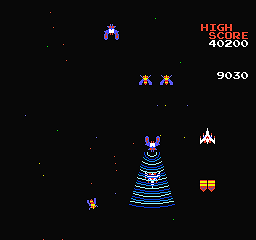 The Game: Commanding a small fleet of sleek fighter ships, you’re up against an alien invasion, arriving in wave after unfriendly wave. Alien fighters resemble butterflies and bees, but the real prize is the handful of motherships which arrives with each wave. Capable of taking two hits – the first weakens them and turns them dark blue, the second destroys them – the motherships also come equipped with a tractor beam with which to snare your fighters. But if one of your fighters is captured, and you can destroy the mothership which is towing it, your wayward fighter will be returned, doubling your firepower. (Bandai, 1988)
The Game: Commanding a small fleet of sleek fighter ships, you’re up against an alien invasion, arriving in wave after unfriendly wave. Alien fighters resemble butterflies and bees, but the real prize is the handful of motherships which arrives with each wave. Capable of taking two hits – the first weakens them and turns them dark blue, the second destroys them – the motherships also come equipped with a tractor beam with which to snare your fighters. But if one of your fighters is captured, and you can destroy the mothership which is towing it, your wayward fighter will be returned, doubling your firepower. (Bandai, 1988)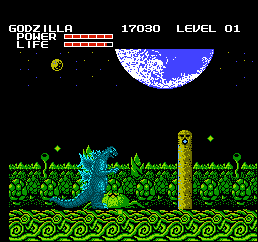 The Game: It is the year 2XXX (don’t worry, we couldn’t find it on our calendars either), and Planet X has declared war on Earth’s solar system, sending its finest kaiju into the fray. In this time of our most desperate need, Godzilla and Mothra step forward to defend the Earth and fight for humanity, taking out enemy installations, spacecraft and even those pesky enemy monsters. But even Godzilla and Mothra can only take so much damage… (Toho Studios/Nintendo, 1988)
The Game: It is the year 2XXX (don’t worry, we couldn’t find it on our calendars either), and Planet X has declared war on Earth’s solar system, sending its finest kaiju into the fray. In this time of our most desperate need, Godzilla and Mothra step forward to defend the Earth and fight for humanity, taking out enemy installations, spacecraft and even those pesky enemy monsters. But even Godzilla and Mothra can only take so much damage… (Toho Studios/Nintendo, 1988)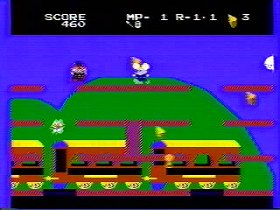 The Game: Mappy the Mouse is back, pursuing his feline arch nemesis Boss The Big Bit and his kitty kohorts through several themed zones of an amusement park. Riddled with ladders, trampolines, secret weapons and treasures, the park goes from wild west to tropical and beyond. Just avoid the cats, lest Mappy become someone’s mousy morsel. (Taxan [under license from Namco], 1988)
The Game: Mappy the Mouse is back, pursuing his feline arch nemesis Boss The Big Bit and his kitty kohorts through several themed zones of an amusement park. Riddled with ladders, trampolines, secret weapons and treasures, the park goes from wild west to tropical and beyond. Just avoid the cats, lest Mappy become someone’s mousy morsel. (Taxan [under license from Namco], 1988)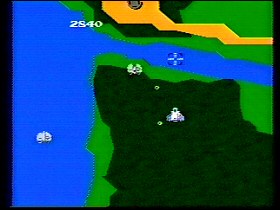 The Game: As the commander of a sleek Solvalou fighter, you’re deep into enemy territory, shooting their disc-shaped fighters out of the sky, bombing ground installations and artillery nests, bombing tanks, and trying to destroy the
The Game: As the commander of a sleek Solvalou fighter, you’re deep into enemy territory, shooting their disc-shaped fighters out of the sky, bombing ground installations and artillery nests, bombing tanks, and trying to destroy the 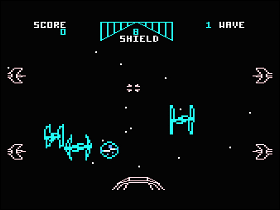 The Game: You’re an intrepid X-Wing pilot participating in the last-ditch Rebel attempt to destroy the Death Star – before it destroys the Rebel base on Yavin IV. TIE Fighters try to intercept you, but you can destroy them (as well as use your own lasers to blast their incoming fire out of the sky). Then you move in to attack the Death Star itself, with its incredibly hazardous system of gunnery towers and bunkers. Once you’ve gotten past the surface defenses, you dive into the trench that will lead you to an exhaust port which is the only means of destroying the Death Star – but there are defenses in the trench as well, and your deflector shields can only take so much… (Domark / Zeppelin Games Ltd., 1988)
The Game: You’re an intrepid X-Wing pilot participating in the last-ditch Rebel attempt to destroy the Death Star – before it destroys the Rebel base on Yavin IV. TIE Fighters try to intercept you, but you can destroy them (as well as use your own lasers to blast their incoming fire out of the sky). Then you move in to attack the Death Star itself, with its incredibly hazardous system of gunnery towers and bunkers. Once you’ve gotten past the surface defenses, you dive into the trench that will lead you to an exhaust port which is the only means of destroying the Death Star – but there are defenses in the trench as well, and your deflector shields can only take so much… (Domark / Zeppelin Games Ltd., 1988)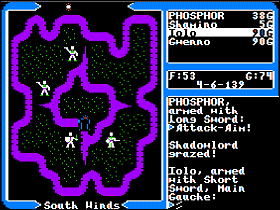 The Game: Darkness has fallen upon the land of Britannia. Lord Blackthorn, with the help and manipulation of the evil Shadowlords, has taken over, banishing Lord British from his own kingdom and ruling over the world with an iron first. Having settled into a little house in the woods after your ascension to Avatar, you are called upon once more to set things right. An underground resistance movement is quietly biding its time, waiting for Lord British to return, and hailing you and your friends as its heroes. But there are also many who have fallen in line behind Blackthorn and his dark masters – and would be happy to dispose of the Avatar for him. (Origin Systems, 1988)
The Game: Darkness has fallen upon the land of Britannia. Lord Blackthorn, with the help and manipulation of the evil Shadowlords, has taken over, banishing Lord British from his own kingdom and ruling over the world with an iron first. Having settled into a little house in the woods after your ascension to Avatar, you are called upon once more to set things right. An underground resistance movement is quietly biding its time, waiting for Lord British to return, and hailing you and your friends as its heroes. But there are also many who have fallen in line behind Blackthorn and his dark masters – and would be happy to dispose of the Avatar for him. (Origin Systems, 1988) The Game: Baseball returns to the small screen – the very small screen – on the Game Boy. Step up to the plate and take a swing; after three outs, take control of the pitcher, basemen and outfield, trying to keep the computer from scoring a run. (Nintendo, 1989)
The Game: Baseball returns to the small screen – the very small screen – on the Game Boy. Step up to the plate and take a swing; after three outs, take control of the pitcher, basemen and outfield, trying to keep the computer from scoring a run. (Nintendo, 1989)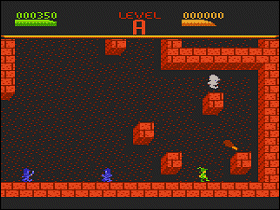 The Game: You control a lone adventurer on a quest through twisty mazes and open battlegrounds, descending through the dungeon depths in search of treasure (and a chance to escape in one piece with that treasure in hand). Zombies, ghosts, and monsters naturally roam through the dungeons as well, more than happy to attack any treasure-hunting interlopers such as yourself. (Atari, 1988)
The Game: You control a lone adventurer on a quest through twisty mazes and open battlegrounds, descending through the dungeon depths in search of treasure (and a chance to escape in one piece with that treasure in hand). Zombies, ghosts, and monsters naturally roam through the dungeons as well, more than happy to attack any treasure-hunting interlopers such as yourself. (Atari, 1988)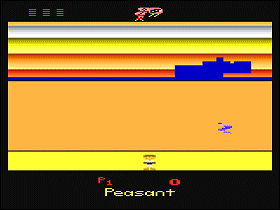 The Game: A worm-like dragon taunts you from atop a multi-colored wall, one which you must topple to reunite your divided village. To accomplish this task, you must bounce hurled projectiles into the wall. Collecting power-ups along the way will affect the behavior of the projectile, from making it a weapon capable of wiping out large portions of the wall to making it return to you repeatedly, like a boomerang. You advance to the next level by eliminating the wall. (Atari, 1989)
The Game: A worm-like dragon taunts you from atop a multi-colored wall, one which you must topple to reunite your divided village. To accomplish this task, you must bounce hurled projectiles into the wall. Collecting power-ups along the way will affect the behavior of the projectile, from making it a weapon capable of wiping out large portions of the wall to making it return to you repeatedly, like a boomerang. You advance to the next level by eliminating the wall. (Atari, 1989) The Game: Q*Bert, a nosey little guy with a propensity for hopping, spends his time hopping around a three-dimensional pyramid of cubes, avoiding Coily the Snake and other assorted purple and red creatures, including a few who operate on a slightly different plane (i.e., they move down the pyramid as if it were rotated one-third). Any green objects and creatures Q*Bert can catch will not hurt him – in fact, the little bouncing green balls will stop time briefly for everyone but Q*Bert. If he gets into a tight spot, Q*Bert can jump off the pyramid onto a flying disc which will despoit him back at the top of the pyramid – and lure Coily to a nasty fate by jumping into nothing. Changing the colors of the top of every cube in the pyramid to the target color indicated at the top left of the screen will clear the pyramid and start the craziness all over again. If Q*Bert is hit by an enemy or falls off the pyramid, he hits bottom with a resounding, arcade- cabinet-shaking splat and a burst of incomprehensible obscenity! (Konami/Ultra, 1989)
The Game: Q*Bert, a nosey little guy with a propensity for hopping, spends his time hopping around a three-dimensional pyramid of cubes, avoiding Coily the Snake and other assorted purple and red creatures, including a few who operate on a slightly different plane (i.e., they move down the pyramid as if it were rotated one-third). Any green objects and creatures Q*Bert can catch will not hurt him – in fact, the little bouncing green balls will stop time briefly for everyone but Q*Bert. If he gets into a tight spot, Q*Bert can jump off the pyramid onto a flying disc which will despoit him back at the top of the pyramid – and lure Coily to a nasty fate by jumping into nothing. Changing the colors of the top of every cube in the pyramid to the target color indicated at the top left of the screen will clear the pyramid and start the craziness all over again. If Q*Bert is hit by an enemy or falls off the pyramid, he hits bottom with a resounding, arcade- cabinet-shaking splat and a burst of incomprehensible obscenity! (Konami/Ultra, 1989)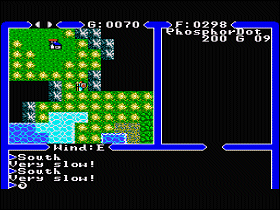 The Game: Darkness has fallen anew upon Britannia, and Lord British calls for your service again. You start out alone, accumulating traveling (and fighting) companions along your journey, striving to live by the Eight Virtues that govern conduct in the kingdom. Along the way, numerous creatures, both evil and simply pesky, challenge you. As you go forth on the quest, you must also collect the mantras of each Virtue, travel to the corresponding Shrines, and meditate there until you reach enlightenment. With enlightenment and experience come the strength to rid Britannia of evil – but beware the dark side… (Sega / Origin Systems, 1989)
The Game: Darkness has fallen anew upon Britannia, and Lord British calls for your service again. You start out alone, accumulating traveling (and fighting) companions along your journey, striving to live by the Eight Virtues that govern conduct in the kingdom. Along the way, numerous creatures, both evil and simply pesky, challenge you. As you go forth on the quest, you must also collect the mantras of each Virtue, travel to the corresponding Shrines, and meditate there until you reach enlightenment. With enlightenment and experience come the strength to rid Britannia of evil – but beware the dark side… (Sega / Origin Systems, 1989)